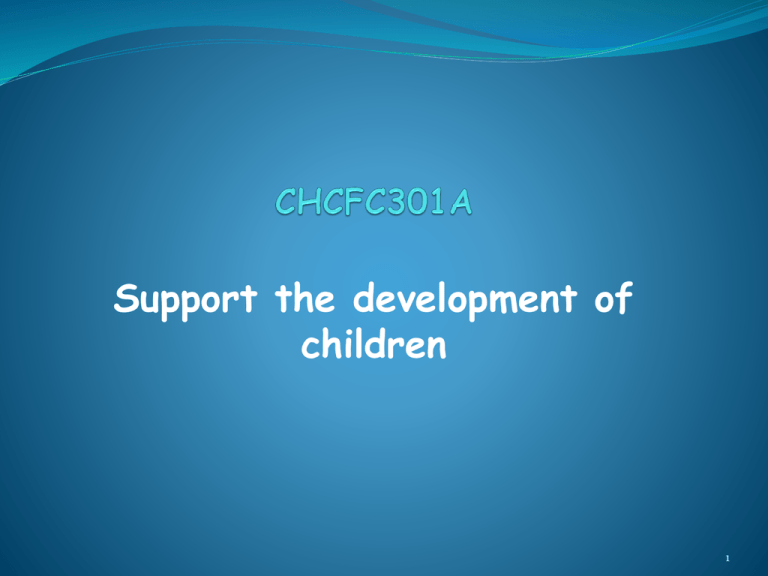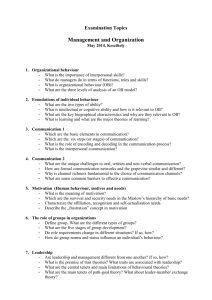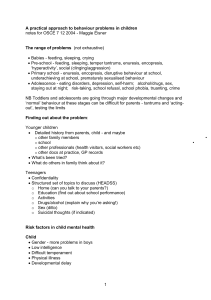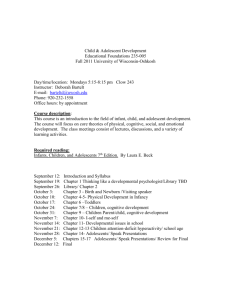chcfc301a - Childcare10
advertisement

Support the development of children 1 What is child development? Berk (2000, p.4) defines child development as “a field of study devoted to understanding all aspects of human growth and change from conception through adolescence”. http://www.sciencephoto.com/image/288781/ 530wm/M8020238-Fertilized_egg_cell-SPL.jpg http://content.answcdn.com/main/content/img/oxford/Oxford_Body/ 019852403x.development-and-growth-school-age-and-adolescence.1.jpg 2 Why study development? Although development continues throughout the life span, your study in this unit focuses on development during childhood. Childhood covers the time span of birth to 12 years. Jot down all the reasons you can think of for learning about child development. Are your reasons similar to these? The more you learn about the developmental process, the better you are able to understand why a child behaves in a certain way. 2. Appropriate care giving strategies are based on child development information 3. Learning about child development gives insights into your own development. You’ll learn how you have developed certain attitudes towards children and their behaviour and needs and how you have developed certain responses when caring for them. 1. 4 4. Learning about child development enables you to identify important influences on a child’s development and helps you understand that how you care for children will influence their behaviour and development 5. Learning about child development enables you to provide an environment that has a positive influence on children’s development. 6. If you have an understanding of typical development, you’ll be alert to possible concerns about a child’s development. 7. If you have knowledge of typical child development you will have realistic expectation of what children are capable of doing at certain ages. Domains/areas of development Physical development: - Gross motor development – the large muscles in the body such as legs, arms, and the chest - Fine motor development – the small muscles such as those in the hand, fingers, lips and tongue. Hand-eye co-ordination is an example of fine motor development - Height and weight growth 6 Domains/areas of development Social/emotional development: - The development of self-concept and self-esteem as well as the ability to express feelings and form relationships with other people. Language development: - Speech – production of sounds (articulation) and voice quality - Language development – understanding or comprehending (receptive language) and being able to communicate using language (expressive language) 7 Domains/areas of development Cognitive (intellectual) development - Thinking processes such as concentrating, imagining, problem-solving, using logic, organising information and using symbols. Language and cognitive development are closely linked. (See Table 1.1 Kearns 2010, An overview of Child Development – from birth to 12 years, page 18 – 24.) 8 KEY CONCEPTS All children have needs that must be met if they are to thrive and develop to their potential. These needs include: Physical needs – shelter, protection, food warmth, health care, rest and activity Psychological needs – affection, consistency, security, trust, quality interactions, appropriate expectations, acceptance and positive attitudes towards unique characteristics; for example, cultural, ethnic and developmental differences Opportunities to learn – access to developmentally appropriate play that fosters development in all areas Respect and self-esteem – a respectful and supportive environment, where their efforts and accomplishments are appreciated and acknowledged. 9 GROWTH AND DEVELOPMENT Growth occurs throughout a person’s life and refers to physical changes and size. The rate of growth varies, with infancy and adolescence identified as rapid growth periods Development is concerned with how organisms change over time. Brain development in the early years of life underpins future mental and physical health and development, learning and behaviour 10 The changes that take place as part of growth and development are the result of two processes: Learning – a permanent change in behaviour that occurs as a result of experience. Learning is dependent on a person’s environment. Maturation – this refers to changes that result from a person’s individual, biologically determined developmental pathway. It is determined by internal signals and not influenced by the environment; for example, when teeth erupt and infant is ready to eat solid food. 11 Through observation, we are able to see how children change as part of the developmental process . quantitative change – changes which involve an increase or decrease and can be measured by: - comparing an individual’s development at different times in their life - comparing an individual’s development with other children of the same age. qualitative change – this reflects a new stage. The ‘quality’ of a function or process changes; for example, the gradual improvement in handwriting (see text book page 12 Other concepts related to growth and development include: Sequence of development refers to the predictable series of steps or stages that the majority of children progress through as part of the developmental process Individual difference – each child is unique. Although the sequence of their development will be ‘normal’, the time taken to move through the sequence will be different. Readiness refers to the time when a child has all the skills necessary to achieve the next step in development. Readiness is linked to maturation. Normal or ‘typical’ growth and development or ‘age-appropriate’ development are terms often used when discussing a child’s development. These terms are generally used to describe development that falls within what has come to be regarded as the ‘usual’ time range for the development of skills and behaviours i.e. A toddler who first walks at 9 months and a toddler who first walks at 11 months would both be considered to be within the normal range of physical development. 13 Stages of Development One way to study patterns of development is to study one stage at a time. The table below shows the main stages of development that occur over the lifespan. Developmental Stage Approximate Age Prenatal Conception to birth Neonate Birth to 4-6 weeks Infancy 4-6 weeks to 18 months Toddlerhood 18 months to 36 months Preschool 3 to 5 or 6 years Middle childhood 5 or 6 to 12 years Adolescence 12 to 18 years Young adulthood 18 to 40 years Middle adulthood 40 to 65 years Late adulthood 65 plus 14 Stages of Development A stage in development covers a specific time period during the lifespan. It is important to remember that the age ranges given for each stage of development are approximate and should be taken only as a guide as to when a child is most likely to be within a particular stage. http://cloud.globalgiving.org/pfil/2047/TZ_mapindunzi_school_group_Grid7.jpg 15 Factors that influence development – the concept of the ‘Whole Child’ As an educator you will want to help each child gain the knowledge, skills and attitudes that allow the child to make the most of their potential and become happy, productive members of their community. When we talk about the ‘whole child’ concept we mean recognising each child as a unique individual, shaped by many influences. Two interacting factors that have a strong influence on individual development are: Heredity – Some areas of development that are said to be linked to heredity include: Gender traits Physical attributes Personality Intelligence Factors that influence development – the concept of the ‘Whole Child’ cont... The physical and social/cultural environment: Environmental factors that affect development include: Social/cultural environment – family, education, religion, culture and economic status Nurturing relationships with primary carers – these are critical to healthy development and have a significant impact on the developing brain Physical environment – health/wellbeing, nutrition, safety and shelter, and geographic location. (See Figure 1.4 – Kearns, 2010 page 6 – The ‘whole child’ – influences on growth and development) BRAIN DEVELOPMENT The brain is the only unfinished organ at birth. Early brain development has a significant impact on learning and behaviour as well as later physical and mental health. Understanding the architecture of the brain and how human relationships and the environment impact on brain development is critical for educators. (See Kearns powerpoint “Brain wonders” on the Wiki) Theories of development Knowledge about development can be informal or formal. You will already have ‘informal’ knowledge about how children grow and behave as a result of your own experience and observations, Formal knowledge about how humans grow and develop is based on the ideas and interpretations (theories) put forward by people who have conducted extensive observation and detailed research. Theories of development also tell us about how humans learn. Formal theories offer accurate and reliable knowledge about growth, development and learning. Most educators tend to take ‘bits and pieces’ from many different theories to assist them in understanding children’s development in order to design appropriate programs for children. There is no single theory that explains how humans develop in all areas. 19 The value of child development theories Knowledge of child development theory and theorists will help you make professional decisions about: What your program structure will be like What the environment will be like What experiences you plan for children How you guide children’s learning and behaviour (See Kearns, Birth to big school page 25 - Theories of development) 20




